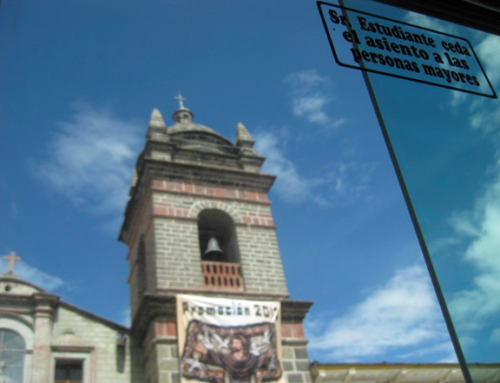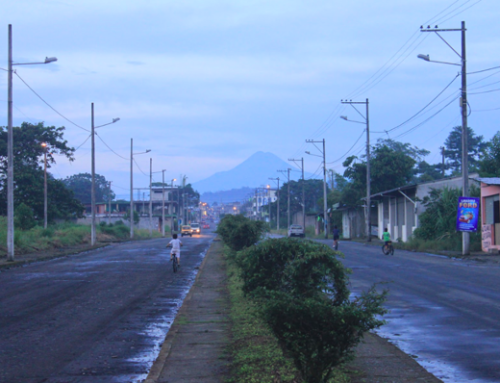As the number of displaced people seeking asylum continues to increase globally, the United States government has enacted policies that undermine access to asylum in the US by shifting responsibility for containing migration to Mexico and other global south countries. Over the past decade, we have been conducting ethnographic fieldwork in nongovernmental migrant shelters that, as a result of these policies, increasingly find themselves picking up the slack for Mexico’s underfunded humanitarian protection infrastructures. In this reflection, we discuss how, as an ethnographic team, we are negotiating what it means to approach care critically amid this embattled system where, like tech companies that outsource digital repair work to an invisible infrastructure of global south workers, aid workers are left struggling to patch together an app whose premises were faulty to begin with. In what follows, we think through connections between CBP One, an app introduced by the US government in February of 2023 that allows the US government to deport asylum seekers who do not first make a digital appointment (Jordan 2023), and the broader place of humanitarian organizations in the global south amid border externalization and attacks on asylum.
The Biden administration announced CBP One in anticipation of the May 2023 lifting of Title 42, a similarly restrictive Trump-era policy that, under the auspices of COVID-19, allowed US and Mexican governments to offload tens of thousands of asylum seekers onto an already struggling network of aid organizations in northern Mexico. Like other forms of digital surveillance, CBP One posits technology as the solution to complex problems while placing responsibility for failures—or “glitches”—onto the platform and user (Precarity Lab 2020). It is already failing people. Early reports indicate widespread app-related issues (Abi-Habib et al. 2023). Some, like a Honduran woman who Díaz De León interviewed in January of 2023, will successfully book an appointment while still transiting through Mexico, hoping to arrive at the border in time. Among those unable to secure an appointment via the app, many will turn away from this digital asylum platform. Instead, they will attempt to cross the border without authorization, risking their lives as they traverse a weaponized border terrain and attempt to avoid being sent back to the violence from which they have fled.
While this overloaded digital infrastructure makes headlines, we turn attention here to a parallel social infrastructure of migrant-serving organizations that finds itself trying to patch together a system that is being dismantled from within. For nearly a decade, our research—first as “lone ethnographers” and now as an ethnographic team—has focused on understanding the everyday politics of humanitarianism and irregular migration between Central America, Mexico, and the US through the lens of nongovernmental aid organizations that parallel migration routes through Mexico. These shelters, concentrated along Mexico’s southern and northern borders, also span the railways and highways that make up major transit corridors throughout the country. Mexico’s migrant shelters have played a central role in documenting violence and resiliency, responding adeptly to the consequences of an ever-shifting immigration policy landscape between the US and Mexico, where inter-country relations swing between cooperation and contention as presidential administrations come and go (Vogt 2018; Brigden 2018; Díaz de León 2023; Casillas 2008; Basok et al. 2015; Doering-White 2022). Most notably, they have long served as the logistical infrastructure of migrant caravans, including the highly mediated caravans of 2018, whose organizers have been the subject of celebration (Frank-Vitale 2019a), critique (Vonk 2022), and repression (Frank-Vitale 2019b).

Migrants shelter, Central Mexico. Photo credit: Alejandra Díaz de León.
Organizers and volunteers working within Mexico’s migrant shelters work within existing asylum regimes and frameworks while also remaining part of them. Enacting care in these spaces means successfully navigating the ambiguities that arise between these positions. In recent years, many of Mexico’s migrant shelters have been transformed from volunteer-run grassroots sanctuaries to sites of professionalized humanitarianism staffed by lawyers, psychologists, and social workers with the support of transnational institutions like UNHCR. These transformations have provided rich ground for critical scholarship, which has tended to come from what might be thought of as a position of “caring diagnosis.” By this, we mean scholarship that primarily focuses on how state ideologies constrain humanitarian possibilities, and how state repression of migrant populations is operationalized through ostensibly caring practices of migration management despite the best intentions of activists and organizers (Doering-White 2018; Galemba et al. 2019; Varela Huerta 2019; Wurtz 2022; Basok and Candiz 2020). Common within these studies, which includes our own work, is a lens of retrospective critique that is attuned to tracing how neoliberal state logics of compassion and repression, which insist upon making distinctions between deserving victims and ruthless criminals, have embedded themselves within everyday practices of care (Fassin 2005; Ticktin 2011). In Mexico as in many other countries at the margins of the west, this dynamic puts shelter workers in the position of having to make the kinds of deservingness distinctions that are embedded in existing asylum frameworks.
What we want to draw attention to here is our own growing sense of discomfort with seeing this form of “caring critique” as sufficient. This feeling is itself informed by moments when we have articulated some of the concerns mentioned above to our interlocutors. During one of these moments, Raúl (pseudonym), the director of a shelter in Central Mexico, responded to Doering-White by saying “And what are we supposed to do with that, sit on our hands (quedarnos de brazos cruzados)?” In posing this question, Raúl pushes us to make two important moves to go beyond critical diagnostics and toward critical collaboration.
Srila Roy’s (2022) scholarship, which tracks the terrain of feminist activism in India, offers us helpful language as we think through these dynamics. Roy explains how India’s economic liberalization made it easier for feminist organizations to receive transnational funds for social development work. This transformation made it possible for the organizations, which had previously been sustained by volunteers (professional women who dedicated themselves above and beyond their formal work hours), to employ a generation of full-time activists. The parallels with the evolution of Mexico’s shelter infrastructure are clear. Roy notes that the most strident critiques of this “NGO-ization” have tended to come from more privileged scholars trained in Western universities, whose arguments paint a polarizing picture in which organizations must decide between autonomy and co-optation. The parallels with our own positionalities as scholars is also clear.
It is here that we begin to articulate what it means for the two of us to both enact and study care not as existing between autonomy and co-optation, or between shelters as sites of either subversive sanctuary or as NGO-ized “humanitarian borders” (Walters 2010), but in a way that is attuned to what Roy describes as “messy entanglements” (2022, 3). We are drawn to Roy’s point that critical Western scholars, “by declaring feminist struggles as co-opted and depoliticized—a thing of the past—[were] also unable to make room for futurity” (Roy 2022). Our engagement with shelters over the past two years has begun shifting from a position of “critical diagnosis” to one of what we have come to think of as critical anticipation. In particular, we have begun turning our attention to climate change as an area where there has been substantive discussion between activists and policymakers about meaningfully expanding asylum to include protection for people experiencing climate-related displacement (Dawson and Laut 2021). After shelters reopened their doors to volunteers and researchers in the Spring of 2021, we spent a portion of that summer at the shelter in Central Mexico where Doering-White has been conducting research since 2014. Arriving in the wake of Hurricanes Eta and Iota, we came to that fieldwork expecting to encounter an elevated number of people experiencing climate-related displacement. We expected many people to report that the most significant climate drivers were not rapid-onset events like hurricanes, but slow-onset drivers like heat, plant disease, and inconsistent rainfall patterns. Over the summer of 2022, we returned to La Casita to more systematically document the fact that such slow-onset drivers of climate displacement often remain formally invisible in the context of the shelter’s intake protocols. This invisibility, while troubling, is not all that surprising given that interpersonal violence—death threats, intimate partner violence, and extortion—are what constitutes legitimate evidence within current international protection frameworks.
What we are turning to now is how to negotiate our place as researchers and build collaborations with shelter workers in an effort to anticipate how the integration of climate change into current asylum frameworks might reconfigure existing forms of humanitarian governance. Indeed, climate change now appears frequently amidst the many overlapping crises that affect asylum-seekers, alongside political instability and violence. These factors are in turn cited to justify policies, like the one that made seeking asylum an app-based process. In thinking about what care might look like in such a context, we find ourselves drawn to scholars like Ingrid Boas and colleagues, who have consistently called the questioning of alarmist discourses of impending climate-induced mass migration, while at the same time working against an understanding of climate migration as exception, rather than as a process that is already intricately intertwined with existing mobilities (Boas et al. 2022). As we wade into this work, we find ourselves grappling with a new set of thorny questions: What does it mean to imagine a better system–to make room for futurity, as Roy puts it–while embattled by constant crisis? How can an orientation of anticipation remain critically attuned to the kind of techno-utopianism that digital infrastructures like CBP One might imagine? At this point, we mainly have questions…
Acknowledgements
Thank you to Ivan Chaar-Lopez for helpful comments on a draft of this essay.
References
Abi-Habib, Maria, Emiliano Rodríguez Mega, Edgar Sandoval, and J. David Goodman. 2023. “Migrants Struggle to Get Appointments on Border Protection App.” The New York Times, May 12, 2023, sec. U.S. https://www.nytimes.com/2023/05/11/us/migrants-border-app-cbp-one.html.
Basok, Tanya, Daniele Belanger, Martha L. Rojas Wiesner, and Guillermo Candiz. 2015. Rethinking Transit Migration: Precarity, Mobility, and Self-Making in Mexico. New York, NY: Palgrave Macmillan.
Basok, Tanya, and Guillermo Candiz. 2020. “Containing Mobile Citizenship: Changing Geopolitics and Its Impact on Solidarity Activism in Mexico.” Citizenship Studies, April, 1–19. https://doi.org/10.1080/13621025.2020.1755160.
Boas, Ingrid, Hanne Wiegel, Carol Farbotko, Jeroen Warner, and Mimi Sheller. 2022. “Climate Mobilities: Migration, Im/Mobilities and Mobility Regimes in a Changing Climate.” Journal of Ethnic and Migration Studies 0 (0): 1–15.https://doi.org/10.1080/1369183X.2022.2066264.
Brigden, Noelle. 2018. The Migrant Passage: Clandestine Journeys from Central America. Ithaca, NY: Cornell University Press.
Casillas, R. Rodolfo. 2008. “Las Rutas de Los Centroamericanos Por México: Un Ejercicio de Caracterización, Actores Principales, y Complejidades.” Migración y Desarrollo 10 (6): 157–74.
Dawson, Grant, and Rachel Laut. 2021. Humans on the Move: Integrating an Adaptive Approach with a Rights-Based Approach to Climate Change Mobility. Brill Nijhoff. https://brill.com/display/title/54511.
Díaz de León, Alejandra. 2023. Walking Together: Central Americans and Transit Migration through Mexico. Tucson, AZ: University of Arizona Press.
Doering-White, John. 2018. “Evidencing Violence and Care along the Central American Migrant Trail through Mexico.” Social Service Review 92 (3): 432–69.
———. 2022. “Shelter Vision: Compassion, Fear, and Learning to (Not) See Trauma Along the Migrant Trail Through Mexico.” Medicine Anthropology Theory 9 (1): 1–27.
Fassin, Didier. 2005. “Compassion and Repression: The Moral Economy of Immigration Policies in France.” Cultural Anthropology 20 (3): 362–87.
Galemba, Rebecca, Katie Dingeman, Kaelyn DeVries, and Yvette Servin. 2019. “Paradoxes of Protection: Compassionate Repression at the Mexico–Guatemala Border.” Journal on Migration and Human Security 7 (3): 62–78. https://doi.org/10.1177/2331502419862239.
Jordan, Miriam. 2023. “Biden Administration Announces New Border Crackdown.” The New York Times, February 22, 2023, sec. U.S. https://www.nytimes.com/2023/02/21/us/biden-asylum-rules.html.
Precarity Lab. 2020. Technoprecarious. London, UK: Goldsmiths Press. https://www.penguinrandomhouse.com/books/659438/technoprecarious-by-precarity-lab/9781912685721.
Roy, Srila. 2022. Changing the Subject: Feminist and Queer Politics in Neoliberal India. Duke University Press.
Ticktin, Miriam. 2011. Casualties of Care: Immigration and the Politics of Humanitarianism in France. Berkeley: University of California Press.
Varela Huerta, Amarela. 2019. “México, de ‘Frontera Vertical’ a ‘País Tapón:’ Migrantes, Deportados, Retornados, Desplazados Internos y Solicitantes de Asilo en México.” Iberoforum 27 (enero-junio 2019): 49–76.
Vogt, Wendy. 2018. Lives in Transit: Violence and Intimacy on the Migrant Journey. Berkeley, CA: University of California Press.
Walters, William. 2010. “Foucault and Frontiers: Notes on the Birth of the Humanitarian Border.” In Governmentality:Current Issues and Future Challenges. Taylor and Francis. https://doi.org/10.4324/9780203846476-10.
Wurtz, Heather M. 2022. “Mobility Imaginaries of Humanitarian Intervention: Gender, Migration, and Violence along Mexico’s Southern Border.” Medical Anthropology Quarterly 0 (0): 0–0. https://doi.org/10.1111/maq.12716.
John Doering-White is Assistant Professor in the College of Social Work and the Department of Anthropology at the University of South Carolina in Columbia, South Carolina. Email: doeringj@mailbox.sc.edu Twitter: @JDoeringWhite.
Alejandra Díaz De León is Profesora-Investigadora at El Colegio de México Centro de Estudios Sociológicos in Mexico City. Email: abdiaz@colmex.mx Twitter: @aledlcp.




